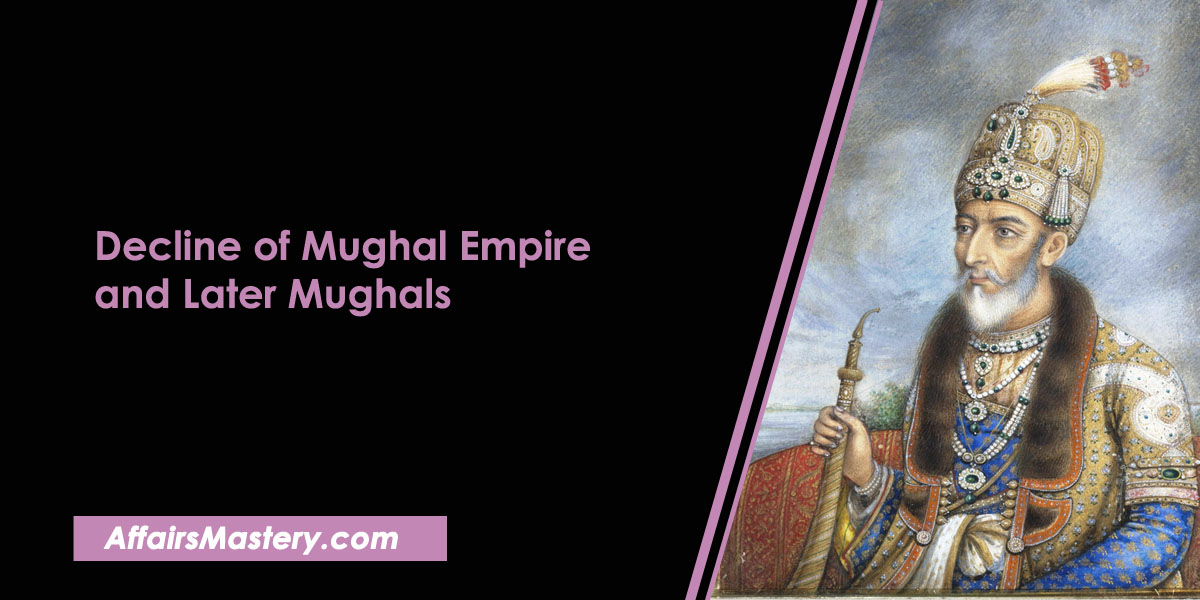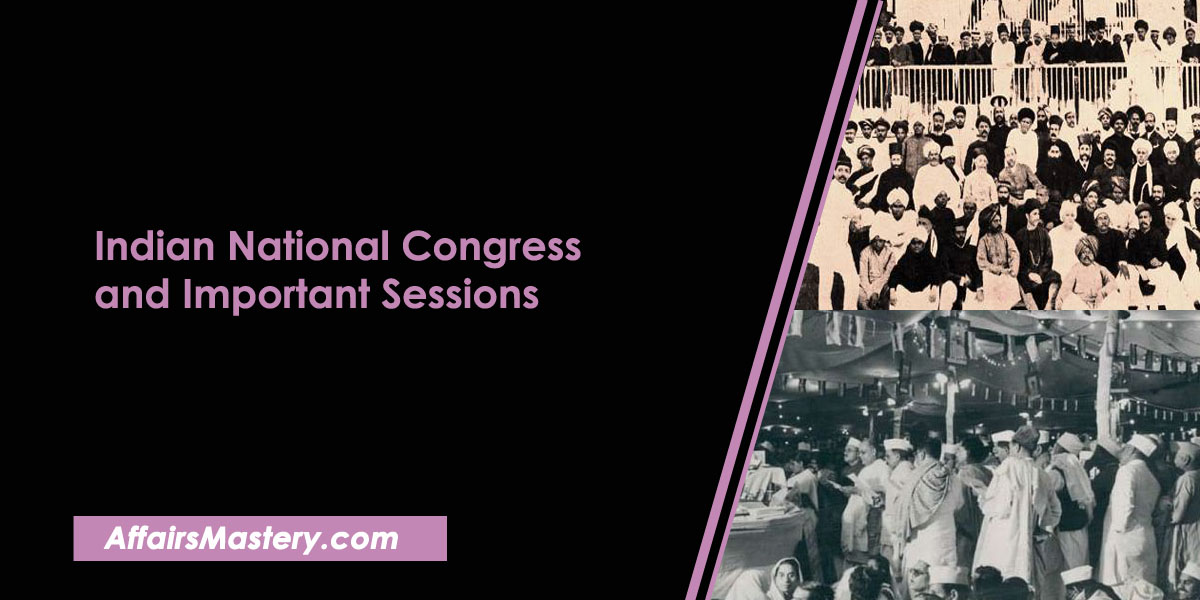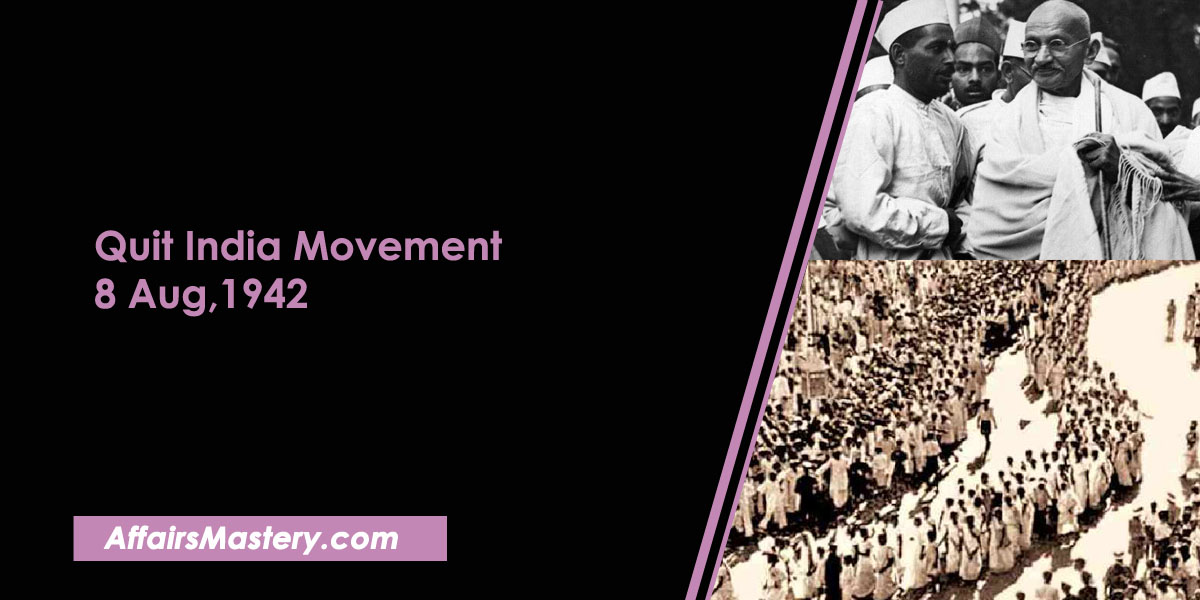Decline of Mughal Empire and Later Mughals – Important Short Notes
Decline of Mughal Empire and Later Mughals. The Mughal Empire, whose foundation was made by Emperor Babur when he claimed power in 1526 and lasted until the death of Aurangzeb began disintegrating onwards. When Aurangzeb passed away, the Mughal empire had spread and grown to be the largest in all of India.
After the death of Aurangzeb, a period of chaos and turmoil ensued as his three sons fought for power. Within fifty years after his passing, the Mughal empire had completely disintegrated due to this warring among siblings. Important Short note for various exams.
From the perspective of an examination like Civil services, State exams, SSC, Banking, Railways and any other One Day exam, all the necessary facts and information are listed below.
Decline of Mughal Empire – Reasons
War of Succession
- After the death of Aurangzeb in 1707, those who succeeded him were known as Later Mughals due to their stark differences from earlier ‘Great Mughals’ such as Akbar and Jahangir.
- Without any clear guidelines for succession, these wars of succession were incredibly destructive and damaging to the Empire as a whole.
- These civil wars caused a disruption in the administrative structure of the Empire, weakening its ability to maintain order and control.
- The nobility, which was the backbone of the empire, by the 18th century, had turned against the Empire.
Jagirdari Crisis
- The Jagirdari system was a way for the Mughal empire to reward their loyal landlords by allotting them jagirs in return for services rendered. This allowed these individuals to gain wealth and power,
- Aurangzeb’s Deccan campaign, though it did expand the frontiers of his Empire, also had a negative effect on jagirdari crisis as it increased the size of nobles and caused bitter struggles among them. for better swathes of land.
- The nobles of the region fought amongst themselves for revenue-rich jagirs, which caused court intrigues and factionalism. This ultimately led to regional aspirations as seen in Hyderabad state’s case.
Ijaradari System and Discontented Peasantry
- Zulfikar Khan worked to improve the financial situation of the empire by carefully monitoring and controlling reckless growth in jagirs and offices, as well as ensuring that mansabdars kept up with their official quota for troops.
- He introduced the practice of revenue farming or Ijaradari.
- The introduction of this system during the reign of Jahandar Shah was a major factor in peasant discontent, as nobles had increasingly high expenses and an extravagant lifestyle that caused them to be unable to meet their obligations.
- The extraction of a larger share of revenue from the peasantry by certain authorities led to revolts among Jats, Sikhs and Satnamis due to their unfair treatment.
Shifting loyalities of Zamindars
- There were three pillars of state during the medieval era – the Emperor at the Centre, the nobles in the middle or provincial level and the Zamindars at the village level.
- Zamindars used titles such as rais, rajas, thakurs, khuts or deshmukjs.
- From the Delhi Sultanate to the Mughal Empire, nearly all central powers have attempted to limit and control zamindar power through their various taxation systems
- Jahandar Shah’s Ijaradari system allowed zamindars to negotiate with nobles and gain hereditary rights over land, which weakened the Imperial authority and overseeing of local administration commanded respect in rural order, which made them the natural leaders and authority figures for peasantry.
Lack of Finances for Central Army
- Under the Mansabdari system, every high official Hindu or Muslim from the governor downwards was required to maintain a contingent in accordance with their rank and status.
- The provincial army, which consist of minor zamindars, who were called upon to render service at the time of war.
- Local forces consist of cavalry, infantry and other arms stationed under Faujdars.
- The military establishment of the Mughal Empire was heavily reliant on finances from Khalisah lands, jagirs and a constant watchful eye by the Emperor over his mansabdars and officials to ensure that prescribed troops were maintained.
- The weak state of agriculture in the region was further aggravated by the Ijaradari system, resulting in soldiers and officers not receiving their salaries for months on end.
Neglect of Science and Technology
- During the period when Europe was experiencing a surge in economic growth due to advances made by the Industrial Revolution, most Indian rulers were preoccupied with internal conflicts which resulted in an overall disregard for science and technology.
- Over emphasis on land as a source of wealth, led to neglect of overseas trade and navy.
- Europeans were investing heavily in new technologies, banking systems, and sepoys to gain more control over their colonies.
Emergence of Regional States
- Awadh, Bengal and Hyderabad were all Mughal provinces that eventually broke away from the empire to become independent states. These can be referred to as Successor States due to their transition from being part of a larger entity into individual entities in themselves.
- Mysore, Kerala and the Rajput states took advantage of destabilization of the Mughal control over their territories.
- Regional groups such as the Maratha, Sikh, Jat and Afghan states were formed due to their rebellion against the Mughal empire. This was a way for them to gain independence from oppressive rule.
Invasion of Nadir Shah and Ahmad Shah Abdali
- Nadir Shah was a ruler of Persia who invaded India in 1739(Battle of Karnal). He is infamous for his cruel and barbaric actions which caused a great deal of suffering to the people under Mughal rule in India, ultimately leading to its downfall.
- The immense wealth of India had sparked Nadir Shah’s insatiable greed, leading him to launch a campaign in order to acquire the riches that were so abundant within its borders.
- Ahmad Shah Abdali was a young Afghan officer of noble lineage. After the assassination of Nadir Shah in 1747, he declared himself as a ruler of Kandahar.
- He invaded India 5 times and fought the Third Battle of Panipat in 1761.
- The regularity of his invasions further highlighted the corruption and decay that had taken hold within the Mughal Empire, making it clear to all how far they had fallen.
List of Later Mughals
Bahadur Shah I (1707-12)
- Death of tyrant and radical Aurangzeb, a fight among his three sons for throne and 65 year old Bahadur Shah came out victorious.
- Bahadur Shah (originally Prince Muazzam) was broad-minded, religiously tolerant and a peaceful person.
- Supported by Jat Chief, Churaman in campaign against Sikhs.
- Struggle continued till 1712 with Sikhs. Also made peace with Bundela chief, Chhatrasal who remained loyal to him.
- Assumed title of Shah Alam I and also known as Shah-i-Bekhabar.
- Made peace with Guru Gobind singh. Granted Sardeshmukhi to Maratha and released Shahu.
- Reckless grant of Jagir and Zamindars, state finances decreased.
- He died in 1712. He was likely the last Mughal ruler to have true power and influence due to his successors who were known for their lack of strength in character as well as their love of extravagance.
Jahandar Shah (1712-13)
- The less abled sons of Aurangzeb were able to ascend the throne with the help and guidance of Zulfiqar Khan, one of his most noble courtiers.
- He was very weak and incompetent. Married to a dancing girl who became his queen.
- He was controlled by nobles and ruled only for one year. He made Zulfiqar Khan, the Wazir.
- He was attacked and killed by his nephew and son-in-law Farrukhsiyar.
- He followed a friendly policy towards the Rajputs, Marathas and the Hindu chieftains in order to strengthen his own position.
- He took a bold step by abolishing the Jaziya tax and adopting an open-minded attitude towards Hindus.
- He gave the title of Mirza Raja Sawai to Jai Singh of Amber and appointed him Governor of Malwa.
- Ajit Singh of Marwar was given the title of Maharaja and appointed the Governor of Gujarat.
Farrukhsiyar (1713-19)
- Farrukhsiyar was able to ascend the throne with assistance from the Sayyid brothers, who were famously known as ‘King Makers’ due to their ability and influence.
- He was completely under the control of Sayyid brothers, who were actually in charge and had a great influence over Mughal empire.
- When he attempted to liberate himself from their oppressive control, they brutally murdered him in cold blood.
- Banda Bahadur, Sikh chief was captured and killed during his reign.
- He was killed in 1719.
Rafi-ud-Darajat (1719)
- He sat on the throne with help from his Sayyid brother, but only for a short period of four months before he passed away due to an unknown disease.
Muhammad Shah (1719-48)
- Nadir Shah attacked and plundered Delhi. Nadir Shah of Iran defeated in Battle of Karnal (1739).
- Took peacock throne with himself and Kohinoor diamond.
- In 1719, Muhammad Shah was installed as the Mughal Emperor by Sayyid brothers who had taken de-facto control of the empire in his name.
- Muhammad Shah was not a good ruler because he had loose morals and enjoyed pleasure-seeking activities, which is why he earned the nickname ‘Rangila‘.
- After the fall of Sayyid brothers, Muhammad Amin Khan was appointed as their first Wazir in 1722. However, Nizam-ul-Mulk soon replaced him and held office until he resigned from his post in 1724 to travel southward.
- During his time, Chin Kilich Khan founded Hyderabad, Murshid Quli Khan founded Bengal and Saadat Khan laid down the foundation of Awadh out of Mughal empire.
Ahmad Shah (1748-54)
- After the death of Emperor Muhammad Shah in 1748, there were intense and bitter struggles between power-hungry nobles from both Turani and Irani factions as they fought for control.
- Ahmad Shah ascended the throne but was unable to cope with the disintegrating forces.
Alamgir II (1754-59)
- After the dethronement of Ahmad Shah, Alamgir II was crowned as the new ruler and took his place on the throne.
- During this period, the emperor’s military and financial power was incredibly weak which made it difficult for him to maintain control over his kingdom.
Shah Jahan III (1759-60)
- Imad-ul-Mulk had placed him on the throne, but unfortunately he was deposed by the Marathas who captured Delhi in 1760 and changed its fate forever.
Shah Alam II (1759-1806)
- During his early years as an emperor, he traveled from place to place out of fear for his own wazir since it was a dangerous and uncertain time..
- He was a man of great ability and courage, but unfortunately the empire had gone too far down its path to be able to redeem itself..
- In 1764, he joined Mir Qasim of Bengal and Shuja ud Daula of Awadh against British.
- Defeated at the hands of British, Shah Alam lived as a pensioner of the East India Company for several years in Allahabad.
- However, he was able to return safely back to Delhi under the protective arm of the Marathas in 1772.
- Howeer, British occupied Delhi in 1803. Mughal Empire served just as the political front for the British.
Akbar II (1806-1837)
- Son of Shah Alam II.
- Gave title of ‘Raja‘ to the Ram Mohan.
Bahadur Shah II (1837-57)
- His Pen name was ‘Zafar‘.
- Bahadur Shah II was the last Mughal Emperor who took part in the 1857 revolt against British rule, leading to his eventual exile and death.
- After being exiled from India, the last Mughal Emperor was deported to Rangoon in Burma where he sadly passed away in 1862.
If you find our content helpful and interesting, please consider joining us on Telegram @affairsmastery_official to show your support. We would really appreciate it!
Related articles
- Important Battles in Indian History 2023-24
- Important treaties in Indian history 2023-24
- List of Foreign Travellers who came to India
- List of Governor General of India and Viceroy of India
- Robert Clive – Important Short Notes for Exams 2023-24
- Warren Hastings – Important Short Notes for Exams 2023-24
- Lord William Bentinck – Important Short Notes for Exams 2023-24
- Lord Canning – Important Short Notes for Exams 2023-24
- Lord Mountbatten – Important Short Notes for Exams 2023-24
- C. Rajagopalachari – Important Short Notes for Exams 2023-24
- Lord Wavell – Important Short Notes for Exams 2023-24
- Lord Linlithgow – Important Short Notes for Exams 2023-24
- Lord Willingdon – Important Short Notes for Exams 2023-24
- Non Cooperation Movement (1919-1922)
- Important Personalities related to Social Movements of India
- List of Important Books on Revolt of 1857 and their Author
- Important Leaders of 1857 Revolt and their places
- Constituent Assembly of India and its Composition: Important Short Notes
- Important Tribal Movements in India
- Direct Action Day 1946: Important Short Notes for Exams
- Interim Government of India, 1946 and its members
- Important Socio Religious Reform Movements in India – Short Notes
- Khilafat Movement (1919-1924) – Important Short Notes for exams
- Lucknow Pact, 1916 – About, Features, Outcome (Important Short Notes)
- C R Formula or Rajaji Formula, 1944 – About, Main Points (Important Short Notes)
- Wavell Plan, 1945 – About, Main Points (Important Short Notes)









